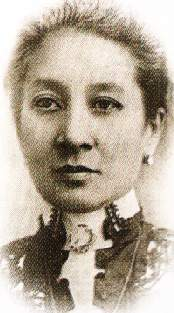
Back مارسيلا أغانسيو Arabic Marcela Agoncillo Spanish Marcela Agoncillo French Մարսելա Ագոնսիլո Armenian Marcela Agoncillo ILO Marcela Agoncillo Dutch Marcela Agoncillo Portuguese Агонсильо, Марсела Russian Marcela Agoncillo Tagalog
Doña Marcela Mariño Agoncillo | |
|---|---|
 | |
| Born | Marcela Coronel Mariño June 24, 1859 |
| Died | May 30, 1946 (aged 86) |
| Resting place | Santuario del Santo Cristo |
| Nationality | Filipino |
| Other names | Doña Marcela, Lola Celay |
| Education | Santa Catalina College |
| Known for | Her legacy as the Mother of the Philippine Flag and principal seamstress of the first and official Philippine flag |
| Spouse | Don Felipe Encarnacion Agoncillo |
| Children | 6 (incl. Lorenza Agoncillo) |
Doña Marcela Mariño de Agoncillo (née Mariño y Coronel; June 24, 1859 – May 30, 1946)[1][2][3] was a Filipina who was the principal seamstress of the first and official flag of the Philippines,[4] gaining her the title of "The Mother of the Philippine Flag."
Marcela Coronel Mariño was the daughter of Don Francisco Diokno Mariño and Doña Eugenia Coronel Mariño, a rich family in her hometown of Taal, Batangas. She finished her studies at Santa Catalina College, Marcela acquired her learning in music and feminine crafts. At the age of 30, Marcela Coronel Mariño married Felipe Encarnacion Agoncillo, a Filipino lawyer, and a jurist, and gave birth to six children. Her marriage led an important role in Philippine history. When her husband was exiled in Hong Kong during the outbreak of the Philippine Revolution, Marcela Mariño Agoncillo and the rest of the family joined him and temporarily resided there to avoid the anti-Filipino hostilities of the occupying Spain. While in Hong Kong, General Emilio Aguinaldo requested her to sew the flag that would represent the Republic of the Philippines. Doña Marcela Mariño de Agoncillo, with her eldest daughter Lorenza and a friend Delfina Herbosa de Natividad, niece of Dr. Jose Rizal, manually sewed the flag in accordance with General Emilio Aguinaldo's design which later became the official flag of the Republic of the Philippines.
While the flag itself is the perpetual legacy of Doña Marcela Mariño de Agoncillo,[5] she is also commemorated through museums and monuments, such as the marker in Hong Kong (where her family temporarily sojourned), and her ancestral home in Taal, Batangas which has been turned into a museum (known as the Agoncillo–Mariño House).[6] She has also been commemorated in paintings by notable painters as well as through other visual arts.
- ^ "Miriam College Library". Mc.edu.ph. Archived from the original on 6 May 2006.
- ^ Mercado, Monina A. (1977), Profiles in Achievement, Philippine Appliance Corp., p. 58, retrieved 29 November 2007
- ^ Zaide, Gregorio F. (1968), The Philippine Revolution, Modern Book Company, pp. 194–195
- ^ The Philippine Revolution, Sunday Times Magazine, 1969, p. 15, retrieved 29 November 2007
- ^ Cite error: The named reference
ManilaBulwas invoked but never defined (see the help page). - ^ Culture Dept. of Education, and Sports, Philippines (1989), Duyan Ng Magiting: The Folk Culture of the Southern Tagalog Region, Dept. of Education, Culture, and Sports, Republic of the Philippines, p. 180, ISBN 978-971-10-1241-0, retrieved 28 November 2007
{{citation}}: CS1 maint: multiple names: authors list (link)